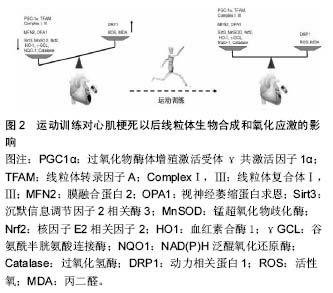| [1] OKeefe JH PH, Lavie CJ, et al. Potential adverse cardiovascular effects from excessive endurance exercise. Mayo Clinic proceedings.2012;87(6): 587-595.
[2] 李顺昌,段意梅,苏全生.力竭性跑台运动致大鼠心肌顿抑现象研究[J].体育科学. 2012,32(8):49-54.
[3] Maranta F, Tondi L, Agricola E, et al.Ivabradine reduces myocardial stunning in patients with exercise-inducible ischaemia. Basic research in cardiology.2015;110(6):55.
[4] Heyndrickx GR, Millard RW, McRitchie RJ, et al.Regional myocardial functional and electrophysiolonical alterations after brief coronary artery occlusion in concious dogs.J Clin Invest.1975;56(4):978-985.
[5] Braunwald E, Kloner RA. The stunned myocardium_ prolonged, postischemic ventricular dysfunction. Circulation.1982;66(6):1146-1149.
[6] 颜姝,韦星,冯大明.心肌顿抑的防治机制新进展.[J]. 中国动脉硬化杂志, 2013,21(12):1149-1152.
[7] Lalonde F, Poirier P, Sylvestre MP, et al. Exercise-induced ischemic preconditioning detected by sequential exercise stress tests: a meta-analysis. Eur J Prev Cardiol.2015;22(1):100-112.
[8] Lalonde F, Poirier P, Arvisais D, et al. Exercise-induced ischemic preconditioning and the potential application to cardiac rehabilitation: a systematic review.J Cardiopulm Rehabil Prev. 2015; 35(2): 93-102.
[9] Quindry JC, Hamilton KL.Exercise and cardiac preconditioning against ischemia reperfusion injury. Current cardiology reviews.2013;9(3):220-229.
[10] Marongiu E, Crisafulli A. Cardioprotection acquired through exercise: the role of ischemic preconditioning. Current cardiology reviews.2014;10(4):336-348.
[11] Rahimi M, Shekarforoush S, Asgari AR, et al. The effect of high intensity interval training on cardioprotection against ischemia-reperfusion injury in wistar rats. EXCLI journal.2015;14:237-246.
[12] 王凯.蛋白激酶C对晚期运动预处理心肌保护效应中缝隙连接蛋白43表达的影响[J].中国运动医学杂志, 2015, 34(11):1079-1084.
[13] 张城林,张艳,吴立玲,等. 运动训练对心肌梗死后心脏的保护作用[J]. 生理科学进展,2015,46(2):137-142.
[14] 贾绍辉,刘君,寇现娟,等. 运动诱导的细胞自噬对小鼠心肌的保护作用[J]. 武汉体育学院学报,2014,48(10): 53-56.
[15] Libonati JR, Gaughan JP, Hefner CA, et al. Reduced ischemia and reperfusion injury following exercise training. Med Sci Sports Exerc.1997;29(4):509-516.
[16] Powers SK,Demirel HA,Vincent HK,et al.Exercise training improves myocardial tolerance to in vivo ischemia-reperfusion in the rat. Am J Physiol. 1998; 275(5 Pt 2):R1468-1477.
[17] Powers SK, Sollanek KJ, Wiggs MP, et al. Exercise-induced improvements in myocardial antioxidant capacity: the antioxidant players and cardioprotection. Free radical research.2014;48(1): 43-51.
[18] Rigg RA, Healy LD, Nowak MS, et al. Heat shock protein 70 (Hsp70) regulates platelet integrin activation, granule secretion and aggregation. Am J Physiol Cell Physiol. 2016;310(7):C568-75
[19] Snoeckx LH, Cornelussen RN, Van Nieuwenhoven FA, et al. Heat shock proteins and cardiovascular pathophysiology.Physiol Rev.2001;81(4):1461-1497.
[20] Meissner A, Luss I, Rolf N, et al. The early response genes c-jun and HSP-70 are induced in regional cardiac stunning in conscious mammals. J Thorac Cardiovasc Surg. 2000 Apr;119(4 Pt1):820-825.
[21] Melling CW, Thorp DB, Milne KJ, et al. Myocardial Hsp70 phosphorylation and PKC-mediated cardioprotection following exercise. Cell Stress Chaperones. 2009;14(2):141-150.
[22] Liu J, Han Q, Peng T, et al.The oncogene c-Jun impedes somatic cell reprogramming. Nature cell biology.2015;17(7):856-867.
[23] Saltin b, Stenberg J.Circulatory response to prolonged severe exercise. J Appl Physiol. 1964;19:833-838.
[24] Homans DC SublettE, Dai XZ, et al. Persistence of regional left ventricular dysfunction after exercise-induced myocardial ischemia. J Clin Invest. 1986 ;77(1):66-73.
[25] Vatner SF HL. Coronary vascular mechanisms involved in decompensation from hypertrophy to heart failure. J Am Coll Cardiol. 1993;22(4 Suppl A):34A-40A.
[26] 李新建,张钢林,刑少东,等.超速驱动诱发大鼠离体心脏心肌顿抑的研究[J]. 成都体育学院学报,2010,36(4):73-77.
[27] 陶小平,苏全生,邹斌,等. 运动诱发大鼠在体心脏心肌顿抑现象的研究[J]. 成都体育学院学报,2011,37(8):83-87.
[28] 李顺昌,段意梅,苏全生.力竭性跑台运动致大鼠心肌顿抑现象研究[J].体育科学. 2012,32(8):49-54.
[29] Oxborough D, Birch K, Shave R, et al. "Exercise-induced cardiac fatigue"--a review of the echocardiographic literature. Echocardiography. 2010; 27(9):1130-1140.
[30] Shave R, Oxborough D. Exercise-Induced Cardiac Injury: Evidence From Novel Imaging Techniques and Highly Sensitive Cardiac Troponin Assays.Progress in Cardiovascular Diseases. 2012;54(5):407-415.
[31] La Gerche A. Can intense endurance exercise cause myocardial damage and fibrosis?. Curr Sports Med Rep.2013;12(2):63-69.
[32] La Gerche A, Heidbuchel H.Exercise-Induced Arrhythmogenic Right Ventricular Cardiomyopathy. Cardiac Electrophysiology Clinics.2013;5(1):97-105.
[33] Guasch E, Benito B, Qi X, et al. Atrial fibrillation promotion by endurance exercise: demonstration and mechanistic exploration in an animal model.J Am Coll Cardiol. 2013;62(1):68-77.
[34] Douglas PS, O'Toole ML, Hiller WD, et al. Cardiac fatigue after prolonged exercise. Circulation. 1987; 76(6):1206-1213.
[35] Middleton N, Shave R, George K, et al. Left ventricular function immediately following prolonged exercise: A meta-analysis. Med Sci Sports Exerc. 2006;38(4): 681-687.
[36] Vanoverschelde JL, Younis LT, Melin JA, et al. Prolonged exercise induced left ventricular dysfunction in healthy subjects.J Appl Physiol.1985; 70(3): 1356-1363.
[37] McGavock J HM, Warburton D, et al.Left ventricular systolic performance during prolonged strenuous exercise in femal triathletes. Dyn Med.2003;2(1):1-8.
[38] Middleton N SR, George K, et al. Left ventricular function immediately following prolonged exercise: A meta-analysis. Med Sci Sports Exerc. 2006;38(4):681-687.
[39] HG P. Marathon run: cardiovascular adaptation and cardiovascular risk. Eur Heart J. 2014;35(44):3091-3098.
[40] Patil HR, O'Keefe JH, Lavie CJ, et al.cardiovascular damage resulting from chronic excessive endurance exercise.Mo Med.2012;109(4):312-321.
[41] Oxborough D SR, Warburton D, et al. Dilatation and dysfunction of the right ventricle immediately after ultraendurance exercise: exploratory insights from conventional two-dimensional and speckle tracking echocardiography. Circulation Cardiovascular imaging. 2011;4(3):253-263.
[42] La Gerche A, Burns AT, Mooney DJ,et al. Exercise-induced right ventricular dysfunction and structural remodelling in endurance athletes. Eur Heart J. 2012;33(8):998-1006.
[43] Elliott AD LGA. The right ventricle following prolonged endurance exercise: are we overlooking the more important side of the heart? A meta-analysis.Br J Sports Med. 2015;49(11):724-729.
[44] Redpath CJ, Backx PH. Atrial fibrillation and the athletic heart. Curr Opin Cardiol.2015;30(1):17-23.
[45] O'Keefe JH, Patil HR, Lavie CJ, et al.Potential adverse cardiovascular effects from excessive endurance exercise. Mayo Clin Proc.2012;87(6):587-595.
[46] Wilhelm M, Roten L, Tanner H,et al. Atrial remodeling, autonomic tone, and lifetime training hours in nonelite athletes. Am J Cardiol.2011;108(4):580-585.
[47] Grimsmo J, Grundvold I, Maehlum S, et al.High prevalence of atrial fibrillation in long-term endurance cross-country skiers: echocardiographic findings and possible predictors--a 28-30 years follow-up study. Eur J Cardiovasc Prev Rehabil.2010;17(1):100-105.
[48] Trivax JE, Franklin BA, Goldstein JA, et al. Acute cardiac effects of marathon running. J Appl Physiol (1985).2010;108(5):1148-1153.
[49] La Gerche A, Burns AT, Mooney DJ, et al. Exercise-induced right ventricular dysfunction and structural remodelling in endurance athletes.Eur Heart J.2012;33(8):998-1006.
[50] Wilson M, O'Hanlon R, Prasad S, et al. Diverse patterns of myocardial fibrosis in lifelong, veteran endurance athletes. J Appl Physiol (1985). 2011;110(6):1622-1626. |
.jpg)

.jpg)
.jpg)